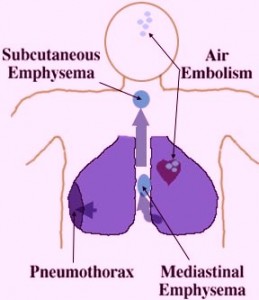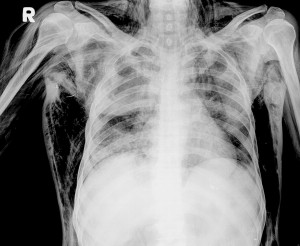Subcutaneous emphysema or sometimes called tissue emphysema is a condition in which air or gas builds up within the skin tissues. This usually occurs when the air escapes from the airways or the lungs through a puncture or a tear. This condition is not really physically painful and patients might only feel uneven lumps and hear crackling sounds especially when these lumps are pressed together. However, complications may arise which can lead to serious life threatening situations due to air blockage or air restrictions.
Symptoms of Subcutaneous Emphysema
The most common symptoms of subcutaneous emphysema are as follows:
• Light swelling
• Neck and chest pain
• Breathing difficulty
• Sore throat
• Swallowing problems
• Wheezing
In severe cases swelling in the face and neck can happen and so is the change in voice. Air bubbles might also spread around the other parts of the body including the limbs and the abdomen.
Causes of Subcutaneous Emphysema
Though this is a rare condition, there are numerous causes why air builds up in our tissues and these include:
• Force from a crash (i.e. after a car accident)
• Gunshot wound or stabbing
• Chest tube trauma – when the air escapes and enters the chest wall
• Facial bone fracture
• Rupture in the esophagus
• Rupture in the bronchial tube
• Forceful vomiting
• Gas gangrene – assault of anaerobic microorganisms on a wound or cut which can be very dangerous.
• May also result after a medical procedure like endoscopy, intubation, bronchoscopy, and central venous line
Diagnosis of Subcutaneous Emphysema
Aside from physical examination, X-rays, blood tests and CT scans are done to verify subcutaneous emphysema. These tests are important to check the patient’s blood pressure, pulse, and to show any increase in the lung size and the patient’s total lung capacity as well. In some cases the patient may only show slight signs hence making diagnosis a bit difficult. Therefore, appropriate diagnostic tests should be conducted to make a confirmation.
A person who shows symptoms of subcutaneous emphysema together with fever, vomiting, left chest pain and looks very ill may be suffering from a life threatening condition called Boerhaave’s Syndrome. In which case, emergency medical attention should be given.
Treatment for Subcutaneous Emphysema
Most of the time treatment is not really necessary for the air build ups will just subside by themselves. But for large air bubbles, medical care is needed to avoid possible interference in breathing.
Treatments may vary based on the underlying causes and symptoms. These treatments may include making small incision to help release the trapped air or even corrective surgery. The patient may be prescribed with pain relieving medications or even supplemental oxygen if necessary.
Prevention of Subcutaneous Emphysema
Subcutaneous emphysema is an irreversible condition. When a person is showing signs of this condition, one should keep in mind to avoid smoking even for just a while to avoid any further complications. Furthermore, avoiding forceful physical exertions can help prevent worsen the condition. Needless to say, rest is recommended. Prevention doesn’t necessarily mean it will not happen, but these tips will help keep the symptoms as mild as possible.
Subcutaneous Emphysema Pictures
Here are photos of Subcutaneous Emphysema to know how the disease affects the body and its functioning.


Thanks for the points you have shared here. One more thing I would like to state is that pc memory needs generally increase along with other breakthroughs in the technological know-how. For instance, when new generations of cpus are brought to the market, there is usually a matching increase in the dimensions calls for of all computer system memory and hard drive space. This is because the software program operated by these processors will inevitably boost in power to make new technology.